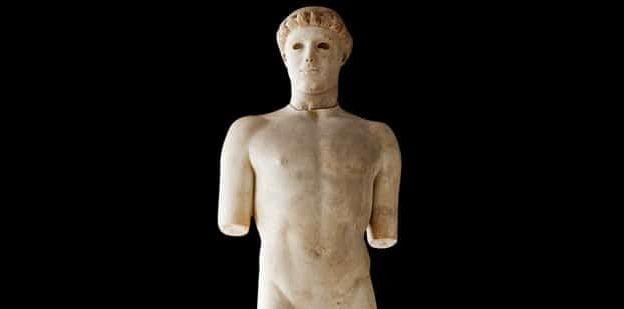
The Kritios Boy, a statue displayed at the Acropolis Museum is one of the most important works of ancient Greek art and the most characteristic of the so-called “Severe Style.”
The statue’s torso was found in 1865 to 1866 southeast of the Parthenon,while the head was found in 1888 near the south walls of the Acropolis. Archaeologists have dubbed it the “Kritios Boy,” after the name of the sculptor believed to have created it.
The “Kritios Boy” is depicted standing in the nude. He supports his weight on his left leg while the right one remains bent at the knee in the characteristic posture of the Severe Style.
Ancient Greek art masterpiece
His expression is solemn and his eyes, which were originally crafted from another material, have not survived.
His hair, which follows the shape of his scalp, is tightly gathered around a ring with a few scattered strands falling on his temples and the nape of his neck. Traces of red dye are preserved on his hair.
The attribution of this statue to the sculptor Kritios is based on the similarities it presents with the statue of Harmodios from the bronze group of the Tyrannicides, a work of Kritios in collaboration with Nesiotes.
This group, known to us today through marble copies of the Roman period, was erected in the Agora of Athens.
Who this statue portrays, however, is not known. Some scholars believe he represents a young athlete, the winner of an event in the celebration of the Greater Panathenaia.
Others claim he depicts a hero, most likely Theseus. Moreover, they link the dedication of the statue on the Acropolis with the activities of 476 to 475 BC, when Kimon transferred Theseus’ bones from the island of Skyros to Athens.
Who beheaded the Kritios Boy statue?
The statue is a touchstone of Greek art. It features prominently in textbooks and it travels to major international exhibitions.
But there is still a mystery over who beheaded the statue in antiquity with an axe-blow to the back of the neck and why.
Early scholars blamed the Persians, who sacked the Acropolis during their invasion of Greece in 480 B.C. More recently, the statue has been dated to the Early Classical period by art historians; this would then imply that the Athenians themselves did the deed.
It is clear that the Athenians did, upon occasion, behead statues; there is no other explanation for the many heads (severed from their no longer preserved bodies) that have been excavated from the Acropolis fill.
Rachel Kousser, a professor of art history at the City University of New York, is pretty sure that the beheading was the work of the Persian invaders.
Writing for the Research Bulletin of The Center for Hellenic Studies, she explains:
Many of the Acropolis korai—dated prior to 480 B.C., and indisputably attacked by the Persians—have parallel injuries, including not only the blow to the back of the head, but also the missing hands and feet.
So, too, mutilation in 480 B.C. would help to explain why the Kritios Boy was interred so soon after it was set up (otherwise, one has to assume it was created in the 470s, and ‘killed’ in thirty years or less, a rather short life expectancy for a sturdy marble statue).
I would guess that the statue was set up shortly before 480, injured, and then buried—all on the Acropolis, since as an inhabitant of sacred space, it could never lose its sanctity.
But it is hard to be sure; this murder mystery from 2,500 years ago offers few clues. What we can say for certain, though, is that this ‘murder’ testifies to the significance of the image, so powerful it had to be ‘killed’ to be negated.



